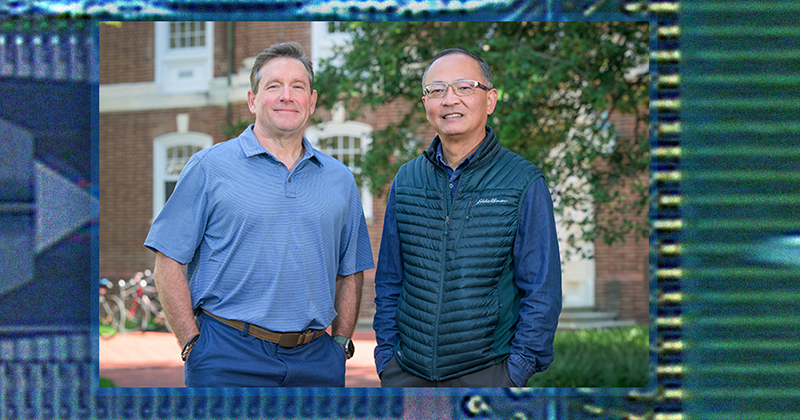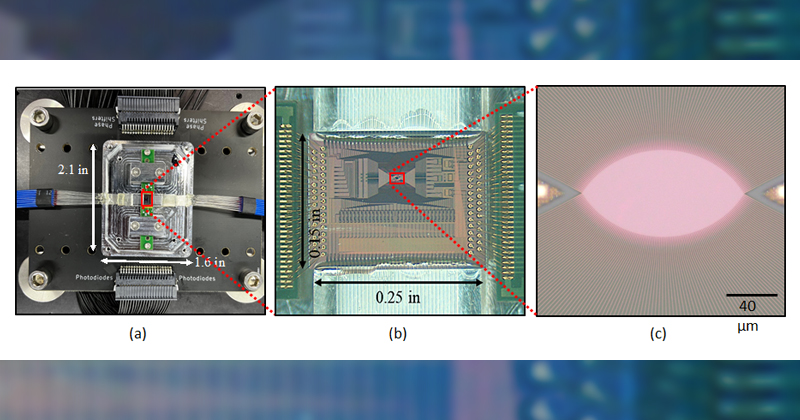


Communicating at the speed of light
Photos by Evan Krape and courtesy of Phase Sensitive Innovations November 21, 2023
UD engineers receive $7.2 million, four-year grant to develop the next generation of wireless communication devices
If you’ve ever sent a T9 predictive text message or owned a smartphone with 4GB of storage instead of 64GB, you’ve seen just how much 21st century communication devices have changed and how wireless technologies like smartphones have revolutionized our day-to-day lives.
Now, nearly five years since high-speed 5G (which stands for 5th generation) wireless devices and networks were first deployed, researchers are already looking toward the future of wireless and how to bring 6G (6th generation) devices and platforms from concept to reality.
At the University of Delaware, researchers in the College of Engineering’s Department of Electrical and Computer Engineering are helping us move from 5G into 6G wireless communications with support from a $7.2 million grant from the Office of Naval Research (ONR). The team, led by Engineering Alumni Distinguished Professor Dennis Prather, Research Professor Xiao-Feng Qi and Delaware State University Professor Mukti Rana, will be developing the next generation of wireless communication devices with advanced sensing and artificial intelligence (AI) capabilities.
Enabling next-generation wireless platforms
Wireless devices rely on waves of electromagnetic energy to transmit information. Most of this takes place on the radio portion of the electromagnetic spectrum, which is composed of lower-frequency waves (ones below 6 gigahertz).
Increasing wireless communication speeds means using higher-frequency waves. And while 5G devices use frequencies up to 28GHz, the experimental 6G bandwidths are at even higher frequencies, from 95 GHz and even into the low terahertz (THz) range.
But using these higher frequencies for communication means addressing a number of technical hurdles with current devices and platforms, Prather and Qi explained. For example, because 6G could be up to 1,000 times faster than 5G, processing these massive amounts of data will require devices that have higher data rates without increasing latency or compromising battery life.
To overcome the limitations of existing wireless devices, Prather and Qi established the Wireless Intelligent Systems Engineering center (UD-WISE), whose goal is to “bridge that gap between leading-edge technologies and societal-based deployments,” Prather said.
“What makes our center unique is the fact that we are combining cutting-edge photonic devices with wireless communications, which is a new technological frontier,” Qi said. “The conventional approach is already being stretched in terms of power consumption and latency, and it is now time to look beyond all-electronic silicon platforms and embrace both electronic and photonic silicon platforms.”
“The UD-WISE center is at the forefront of new technologies combining hardware, AI and systems that will address the ever expanding demands for wireless communications capacity,” said Jamie Phillips, chair of the Department of Electrical and Computer Engineering. “Their work will have a tremendous impact on defense and security, meeting needs of communications in the age of AI, and providing equitable access to high speed internet capabilities. I am thrilled that the UD-WISE center will be leading the next generation of wireless technology right here at UD, and the transformative force it will have on our students, local communities and society.”
Systems-level approaches
The “silicon-adjacent” approach mentioned by Qi involves a shift away from traditional electronic devices that work by manipulating electrons on silicon-based chips toward newer photonic devices that rely on light. Because photons can travel much faster than electrons, photonic devices won’t run into the same technical limitations as electronic devices.
“Our group’s specialty is the ability to use photonics to enhance the electronics,” Prather said. “There's certain things that all electronic systems just don’t do well, especially at higher frequencies, but light does it with ease.”
At the same time, researchers working on 6G applications are interested in pushing the boundary of what everyday communication devices can do. One concept, known as integrated sensing and communication (ISAC for short), involves developing devices that can not only share information but can also collect environmental data and, using advanced AI and machine learning algorithms, respond and react to these changes in real time.
“The whole idea is to have integration between intelligent systems for wireless domains and to create an integrated sensing and communications environment,” Prather said.

“This technology fosters ambience in intelligence and sensing that is critical to many applications, both military and public use,” added Chandra Kambhamettu, professor in the Department of Computer and Information Science and a co-investigator in UD-WISE. “For instance, it can be robust to environmental disturbances and energy efficient under dense, or congested, circumstances.”
Thanks to their new funding from ONR, the UD-WISE team will be able to work on developing and refining their photonics-based devices for ISAC applications. For this grant, the primary focus will be on developing ad-hoc wireless networks for expeditionary forces. Prather, a Navy veteran, cites the notable and impactful communication outages during the ongoing war in Ukraine while explaining the need for a highly reliable communications infrastructure given the challenging, dynamic and unpredictable nature of military operations.
As a co-PI of this grant, DSU’s Rana, professor of physics and engineering, will be developing novel transistors made of an aluminum nitride ferroelectric material to achieve the low-power needs of these advanced wireless communication devices.
The researchers said that in order to succeed with this project, UD-WISE will need to successfully bring together experts in a wide range of fields — and with students and collaborators working in the fields of devices, electron-to-photon conversion, wireless communications, sensing, and artificial intelligence and machine learning (AI/ML). The “S” part of UD-WISE will be key to integrating everything into a collective system-level application, Prather said.
“The exciting part of this work is the cross-disciplinary approach we bring to the table, one that couldn’t be solved by individual domain expertise alone,” Qi said. “We are talking about the synergy between AI and machine learning, electromagnetics, information theory and wireless communication. Each one of them has traditionally been working towards their own ends, and we're bringing them all together to address real-world problems.”
From idea to real-world application
Along with their years of knowledge across both research and industry, Prather and Qi will be leveraging their experience and leadership in this field thanks to research initiatives supported by the CHIPS and Science Act.
“We also have dedicated facilities through small businesses that are also supported by the State of Delaware to actually begin manufacturing some of these technologies,” Prather said. “We are taking it upon ourselves not only to do the research but to become a supplier at the manufacturing level for this technology.”
This new grant also supports collaboration with the Delaware Department Technology and Information to directly apply these new technologies in order to provide high-speed Internet to rural areas of the state.
“We need to make sure the networks we are deploying are future-proof and scalable to advances in the tech-comm space,” said Delaware Broadband Office Executive Director Roddy Flynn. “By collaborating with the visionaries at the University of Delaware, we can plan not just to connect Delawareans to the best networks today, but make sure Delaware is at the cutting edge of connectivity for a generation.”
For Qi, long-term success for this project would mean seeing autonomous, intelligent wireless networks that can adapt and respond to their surroundings deployed broadly.
“The driving vision for us is that 10 years from now we will see wireless networks that know where its users are and what their needs are and are self-regulating in an adaptive and intelligent way,” he said.
Prather added that because of the newness of this technology, it’s challenging to predict exactly what the future might hold — which is in part what makes this area so exciting to work in.
“ISAC involves bringing each of these technical worlds together: communications, where we exchange information; sensing, where we have an awareness of the environment; AI/ML, where can interpret information and make decisions; and wireless/integrated technologies that enable the high-speed/low-power transmission and processing of that information,” Prather said. “With ISAC, we’ll be able to communicate based on our situational awareness and couple that to an optimal assessment of immediate and long-term requirements, which opens up a new dimension of what our devices can do for us. Even though we can't put our finger on all the amazing things that it's going to be able to eventually do, one thing's for sure — unless we build it, they will not come.”
Contact Us
Have a UDaily story idea?
Contact us at ocm@udel.edu
Members of the press
Contact us at 302-831-NEWS or visit the Media Relations website

